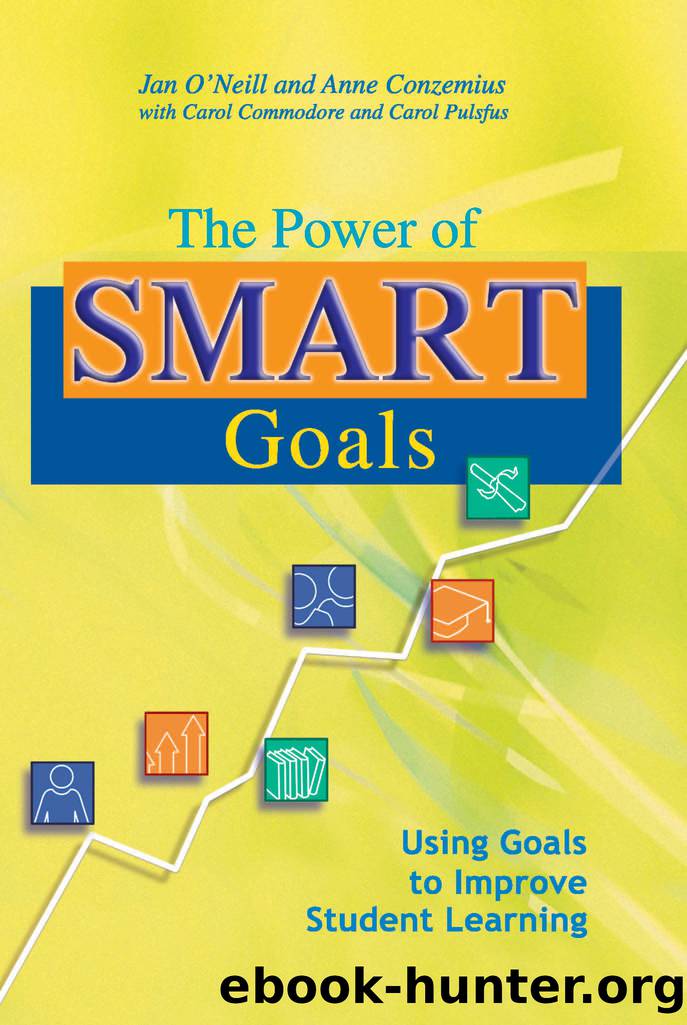The Power of SMART Goals by Conzemius Anne;O'Neill Jan; & Anne Conzemius

Author:Conzemius, Anne;O'Neill, Jan; & Anne Conzemius
Language: eng
Format: epub
Publisher: Solution Tree
Published: 2006-08-15T00:00:00+00:00
Figure 4.4: Zone Scoring Chart
In order to avoid the pitfalls of administering an assessment that does not yield the information needed, we recommend taking a PDSAâPlan-Do-Study-Actâapproach. Write the assessment, test it on a small scale (preferably on yourselves as a team as well as on several students), make improvements, and finally administer the revised assessment.
3. Identify Proficiency Levels That All Students Should Achieve
To identify proficiency targets, it is helpful to first establish a basis. This is why it is so important to administer the common assessment as early in the year or semester as possible. In addition, teams will need a process for understanding results and determining next steps. We recommend using Bruce Wellman and Laura Liptonâs (2004) powerful process for inquiring into data, which they call âThe Collaborative Learning Cycle.â The cycle is based on a learning process that first invites teams to consider their assumptions, then investigate the data directly, and finally develop solutions. Using this cycle, the team can move scoring from a simple mechanical procedure to a much deeper, more meaningful discussion of student learning.
Wellman and Lipton call the first phase in the cycle âactivating and engaging.â This phase precedes looking at the data. It is where we reveal our assumptions and expectations about what we think we will see. According to Wellman and Lipton, âNaming and exploring these assumptions before the data is present opens possibilities for reframing and rethinking habits of mind that tacitly and overtly guide instructional decision-making and teaching practicesâ (p. 45). If the heart of the question truly is âWhat do we need to change in our instructional practices to ensure each student is learning?â then this step is surely a crucial one.
Imagine our eighth-grade team has administered their common assessment diagnostically as a baseline. Before they score results, the âactivating and engagingâ questions our team asks include:
⢠What assumptions do we have about our students?
⢠What do we expect to see when we look at how our students did on this assessment?
⢠What questions do we have?
⢠What are some possibilities for our learning that this experience (of using SMART goals and common assessments) presents to us?
The second phase in the Wellman/Lipton cycle is âexploring and discovering.â This is where we analyze the data, the âheart of collaborative inquiry,â in Wellman and Liptonâs words. It is important in this step that we depersonalize the data, making it emotionally easier to look at. This is not an issue when looking at baseline data from a common assessment, but later on, after instruction has occurred, it would be easy to drop into defensive posturing. The first step begins with the team summarizing their studentsâ scores in one place and highlighting the color-coded zones (figure 4.5, page 96).
Download
This site does not store any files on its server. We only index and link to content provided by other sites. Please contact the content providers to delete copyright contents if any and email us, we'll remove relevant links or contents immediately.
Macmillan Primary Grammar 2 Pupil's Book by Unknown(378)
Figuring Out Fluency in Mathematics Teaching and Learning, Grades K-8 by Jennifer M. Bay-Williams & John J. SanGiovanni(342)
The Principal's Guide to Curriculum Leadership by Sorenson Richard D.;Goldsmith Lloyd M.;Mendez Zulma Y.;Maxwell Karen T.;(266)
English Grammar Practice--The Noun by Roxana Nastase(228)
Learning from Accidents 3rd ed by Trevor Kletz (2001)(226)
Harnessing Technology for Deeper Learning by Scott McLeod(215)
Text-Dependent Questions, Grades K-5 by Douglas Fisher & Nancy Frey & Heather Anderson & Marisol Thayre(208)
A Guide to Curriculum Mapping by Hale Janet A.;(202)
English Language Program Administration by Unknown(199)
Deep Change Leadership by Reeves Douglas;(190)
How to Do Everything with Google Tools by Unknown(188)
The Grammar Teacher's Activity-a-Day by Jack Umstatter(178)
The Power of SMART Goals by Conzemius Anne;O'Neill Jan; & Anne Conzemius(175)
Beyond the RTI Pyramid by Bender William N.;(158)
Aligning and Balancing the Standards-Based Curriculum by Squires David A.;(156)
Using Data to Close the Achievement Gap by Johnson Ruth S.;(156)
Using Equity Audits to Create Equitable and Excellent Schools by Skrla Linda E.;McKenzie Kathryn B.;Scheurich James Joseph;(151)
Differentiated Instructional Strategies for the Block Schedule by Gregory Gayle H.;Herndon Lynne E.; & Lynne E. Herndon(145)
You've Got to Reach Them to Teach Them by Schreck Mary Kim; & Schreck(140)
